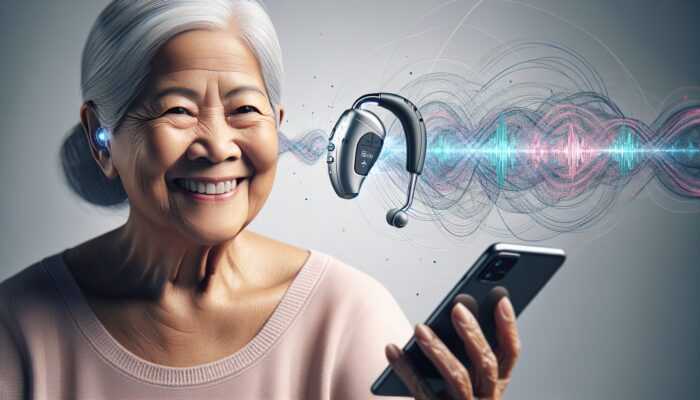Transformative Technological Innovations in Hearing Aids for 2025
Remarkable advancements in hearing aid technology are significantly altering the landscape for millions of individuals experiencing hearing loss. The year 2025 represents a crucial milestone in the evolution of hearing aids, with innovations concentrating on improving user experience, comfort, and functionality. This article delves into some of the most thrilling enhancements that are paving the way for the future of hearing devices, providing insights into how they will impact users’ lives.
Revolutionary Miniaturization Techniques in Hearing Aid Design

The ongoing trend toward miniaturization in hearing aids has led to the creation of devices that are not only smaller in size but also remarkably discreet. Cutting-edge micro-engineering techniques empower manufacturers to produce potent devices that fit snugly within the ear canal or discreetly behind the ear, significantly reducing visibility while enhancing user comfort. This compact design approach encourages greater acceptance among users, especially among younger individuals who may prioritize aesthetics in their auditory solutions.
Moreover, these miniaturized components have not compromised performance; in fact, advancements in technology have enabled these small devices to incorporate high-quality sound processing capabilities. This ensures that users experience crystal-clear audio without the intrusion of distracting background noise. The synergy of size and power greatly enhances the overall user experience, allowing wearers to engage more fully in daily conversations without feeling self-conscious about their hearing aids.
Significant Enhancements in Sound Processing Technology
The sound processing capabilities of hearing aids have experienced a remarkable transformation, thanks in large part to sophisticated algorithms designed to deliver clearer sound and superior noise reduction. These advanced algorithms analyze sound environments in real-time, effectively distinguishing between speech and background noise, which is particularly essential in bustling public places such as cafés and urban settings.
The outcome of such innovation? Users can participate in conversations without the exhausting effort of trying to hear over disruptive sounds. The improvements in sound processing technology not only elevate daily interactions but also enrich the quality of life for individuals who often grapple with feelings of isolation due to their hearing challenges. Whether at social gatherings or in professional meetings, these devices empower users to engage and communicate with confidence.
Seamless Wireless Connectivity Features in Hearing Aids
As we continue to integrate technology into nearly every facet of our lives, the next generation of hearing aids embraces effortless wireless connectivity. These devices are capable of connecting to smartphones, tablets, and even smart home systems, offering an array of functionalities that elevate the auditory experience to a new level of personalization.
For example, users can stream music or phone calls directly to their hearing aids, eliminating the need for cumbersome additional accessories. This seamless connectivity not only enhances convenience but also positions hearing aids as central hubs in the user’s digital ecosystem. Consequently, wearers can indulge in a more immersive auditory experience, effectively bridging the divide between hearing devices and contemporary technology.
Artificial Intelligence’s Impact on the Future of Hearing Aids in 2025

Artificial intelligence (AI) is fundamentally transforming the landscape of hearing aids by introducing capabilities that adapt to individual user needs and their environments. The integration of AI into hearing devices brings about unprecedented levels of personalization and efficiency, ushering in a new era of auditory support.
Creating Personalized Sound Profiles with AI Technology
Picture a hearing aid that intuitively learns from your listening habits and preferences, automatically adjusting sound settings to suit different environments. AI-powered hearing aids are achieving just this, crafting personalized sound profiles tailored to each user’s unique hearing requirements.
By continuously analyzing feedback from the wearer, these devices adjust settings in real-time, ensuring optimal sound quality whether in a serene room or a bustling street. This degree of customization not only enhances user satisfaction but also cultivates a sense of independence among those who may have felt constrained by their hearing challenges in the past. The ability to fine-tune auditory experiences according to individual preferences significantly optimizes the overall utility of hearing aids.
Real-Time Language Translation Capabilities in Hearing Aids
In our increasingly interconnected global society, the capability to communicate across language barriers has become essential. Innovative hearing aids equipped with AI can perform real-time language translation, enabling users to engage more effectively in multilingual environments.
This transformative technology enhances experiences during travel, academic pursuits, and social interactions. Imagine attending an international conference and seamlessly understanding presentations from speakers of various languages without requiring extensive prior preparation. The ability to translate languages in real-time via hearing aids not only empowers users in diverse situations but also promotes inclusivity by breaking down communication barriers.
Predictive Maintenance Features in AI-Integrated Hearing Aids

The future of hearing aids not only focuses on sound quality enhancement but also emphasizes ensuring that devices remain functional and reliable. The integration of AI enables predictive maintenance, allowing the hearing aids to monitor their own health and performance.
Through ongoing self-assessment, these devices can alert users when maintenance is necessary—such as battery replacements or software updates—before issues manifest. This proactive strategy minimizes downtime and ensures that users can depend on their hearing aids for uninterrupted support, ultimately boosting user confidence and satisfaction.
Battery Life Enhancements Revolutionizing Hearing Aids in 2025
As technology advances, so too do the energy solutions powering hearing aids. Improvements in battery life are critical, enabling users to enjoy extended usage times with increased convenience and reliability.
Extending Battery Duration for Enhanced Usability
Today’s users are seeking hearing aids that provide prolonged use without the frequent hassle of recharging or replacing batteries. The latest breakthroughs in battery technology have resulted in batteries that last significantly longer, greatly reducing the inconvenience associated with device upkeep.
This evolution ensures that users can maintain an active lifestyle without the constant anxiety of their hearing aids depleting power unexpectedly. Whether spending an adventurous day hiking through scenic landscapes or attending a series of back-to-back meetings, users can trust that their devices will last as long as their activities do.
Revolutionary Rechargeable Hearing Aid Options
The emergence of rechargeable hearing aids is transforming the user experience, allowing individuals to simply place their devices in a charging dock overnight and wake up to fully powered hearing aids, thereby eliminating the need for traditional batteries.
This shift not only results in long-term cost savings—given the ongoing expense of disposable batteries—but also aligns with more sustainable practices. Users can take pride in making an environmentally responsible choice while enjoying the seamless functionality of modern hearing aids.
Energy-Efficient Technologies Enhancing Hearing Aid Performance
Innovations in energy-efficient technology have enabled hearing aids to consume less power while delivering exceptional performance. This advancement serves to extend battery life and enhance the longevity of the devices themselves.
By minimizing energy consumption, manufacturers are paving the way for a future where hearing aids are not just tools for communication but also eco-friendly gadgets that contribute to a sustainable world. The fusion of technology and sustainability presents an appealing option for a growing number of environmentally conscious consumers who value responsible technology.
Fast Charging Technology for On-the-Go Convenience
The advent of fast charging capabilities in hearing aids represents a major breakthrough for users with active lifestyles. Thanks to advancements in charging technology, devices can now achieve significant power boosts in a remarkably short time, drastically minimizing downtime.
Imagine being able to charge your hearing aids for just 30 minutes and receiving hours of usage in return. This convenience is invaluable, especially for those who may forget to charge their devices overnight or require a quick solution during their busy day. Fast charging provides a seamless experience that alleviates anxiety over device performance, making hearing aids more reliable than ever before.
Design and Comfort Innovations in Hearing Aids for 2025
The overall design and comfort of hearing aids have experienced significant advancements, ensuring that they are both functional and aesthetically pleasing. As we examine these enhancements, it becomes evident that user satisfaction is a top priority in design considerations.
Ergonomically Designed Hearing Aids for All-Day Comfort
Comfort is paramount when it comes to wearing hearing aids for extended periods. New ergonomic designs have been developed to ensure that devices fit comfortably in or on the ear, effectively reducing pressure points and irritation.
These thoughtful design improvements enable users to wear their hearing aids throughout the day without discomfort. By prioritizing wearability, manufacturers are encouraging more individuals to embrace these essential devices, ultimately enhancing their quality of life and social interactions.
Customizable Aesthetics for Personal Expression
In today’s world, personal expression is vital, and customizable aesthetics allow users to showcase their unique personalities through their hearing aids. Many manufacturers now provide options for colors, styles, and designs, enabling individuals to select devices that resonate with their personal taste.
This level of customization not only boosts user satisfaction but also helps mitigate the stigma associated with wearing hearing aids. When users can personalize their devices, they cultivate a sense of ownership and pride in their technology, fostering a positive attitude toward hearing support.
Hypoallergenic Materials for Enhanced Comfort
The choice of materials used in hearing aids directly affects user comfort. With many individuals experiencing skin sensitivities or allergies, manufacturers are increasingly turning to hypoallergenic materials for hearing aid construction.
These innovative materials diminish the risk of skin irritation and allergic reactions, ensuring that users can wear their devices confidently and comfortably. This focus on utilizing user-friendly materials underscores the industry’s commitment to improving the overall experience for hearing aid wearers, making them more approachable and enjoyable.
Improving Accessibility and Affordability of Hearing Aids in 2025
The landscape of hearing aids is evolving to make them more accessible and affordable for a broader audience. As we explore these changes, it’s apparent that barriers to receiving hearing support are gradually being dismantled.
Over-the-Counter Hearing Aid Options for Greater Accessibility
The introduction of over-the-counter (OTC) hearing aids represents a groundbreaking shift within the industry, allowing individuals to purchase devices without the requirement for a prescription. This newfound accessibility empowers users to take control of their hearing health, simplifying the process of finding solutions that meet their needs.
OTC options also pave the way for increased competition among manufacturers, which can ultimately drive down prices, making essential auditory support more accessible to those who need it most. This democratization of hearing aid technology is crucial in ensuring that everyone has the opportunity to benefit from improved hearing.
Expanded Insurance Coverage for Hearing Aids
Traditionally, hearing aids have been linked to significant out-of-pocket expenses, discouraging many individuals from seeking the necessary support. Fortunately, a growing number of insurance providers are beginning to offer more comprehensive coverage for hearing aids, thus reducing financial barriers for users.
As more insurance plans recognize the importance of hearing health within the broader context of overall well-being, individuals can access quality devices without facing overwhelming costs. This shift indicates a growing acknowledgment of the importance of addressing hearing loss as a critical public health issue that deserves attention and resources.
Government Subsidized Programs for Hearing Aid Affordability
Several government and non-profit organizations are actively working to provide subsidies for the cost of hearing aids for individuals in need. These programs assist low-income families and those experiencing financial hardships in acquiring the technology necessary for effective communication.
By offering financial support, these initiatives play a vital role in ensuring that everyone can access the auditory assistance they deserve. This commitment to enhancing accessibility underscores the notion that hearing health is fundamental for social integration and an improved quality of life.
Enhancements in Telehealth and Remote Adjustments for Hearing Aids in 2025
The rise of telehealth has transformed how individuals receive healthcare, including essential audiology services. The ability to make remote adjustments to hearing aids is becoming more commonplace, significantly enhancing convenience and access for users worldwide.
Remote Programming Capabilities for User Convenience
Remote programming features enable audiologists to make adjustments to hearing aids from afar, removing the necessity for in-person appointments. This flexibility is particularly advantageous for users in remote locations or those facing mobility challenges.
The convenience of remote programming guarantees that users can receive timely support and adjustments without the inconvenience of traveling. Whether it’s fine-tuning sound settings or troubleshooting issues, this service significantly improves the overall user experience, facilitating ongoing care and support.
Virtual Consultations for Improved Access to Audiology Services
Telehealth services have made it easier than ever for users to receive professional advice and support. Virtual consultations enable individuals to connect with audiologists from the comfort of their homes, streamlining the process of obtaining expert guidance and assistance.
This accessibility reduces barriers often associated with traditional consultations, making it more convenient for users to seek help. By leveraging technology to facilitate communication, virtual consultations promote a proactive approach to hearing health and comprehensive device management.
Collaborative Data Sharing with Healthcare Providers
The capacity to share hearing aid data with healthcare providers is a revolutionary development for ongoing management and care. With data readily available, audiologists can monitor users’ hearing experiences and make informed decisions regarding adjustments and support.
Data sharing encourages a collaborative approach to care, ensuring that users receive personalized support tailored to their specific hearing needs. The integration of technology and healthcare continues to enhance the overall efficacy of hearing aid solutions, creating a more comprehensive support system for users.
Integrating Hearing Aids into Holistic Health Ecosystems in 2025
The future of hearing aids extends beyond mere auditory support; they are increasingly becoming vital components of broader health ecosystems. This integration enables a comprehensive approach to monitoring and maintaining user health, providing a deeper understanding of overall well-being.
Health Monitoring Features in Modern Hearing Aids
Modern hearing aids are now equipped with health monitoring capabilities, allowing users to track vital signs such as heart rate and activity levels. These features empower individuals to take charge of their overall health by providing valuable insights into their well-being.
By incorporating health monitoring into hearing aids, users can adopt a proactive approach to their health management. This additional layer of functionality transforms hearing aids into multifunctional devices that contribute positively to users’ overall quality of life, far beyond auditory assistance.
Fall Detection Technology for Enhanced User Safety
Safety is essential, particularly for older adults or individuals with mobility challenges. Some hearing aids now incorporate fall detection technology, which can alert emergency services when a fall is detected.
This feature provides peace of mind for users and their families, knowing that help is just a notification away. The ability to detect falls and respond quickly can be life-saving, reinforcing the importance of incorporating safety-enhancing technologies into hearing devices, making them indispensable for vulnerable populations.
Seamless Integration with Wearable Health Devices
Hearing aids are increasingly designed to sync with other health-related wearables, such as fitness trackers and smartwatches. This synchronization creates a holistic health profile, allowing users to gain insights into both their physical and auditory health simultaneously.
By integrating hearing aids with wearables, users can monitor trends, set health goals, and develop a comprehensive understanding of their overall well-being. This holistic approach encourages a lifestyle focused on wellness, making hearing aids an essential part of an individual’s health ecosystem.
Improved Data Sharing Practices with Healthcare Providers
Secure data sharing between hearing aids and healthcare providers enhances patient monitoring and treatment plans. With real-time access to data, audiologists can make informed decisions regarding care, optimizing the user experience for better outcomes.
This exchange of information fosters a more collaborative relationship between users and healthcare providers, ensuring that individuals receive the support they need and deserve. By leveraging technology effectively, the healthcare system can provide tailored solutions that enhance the efficacy of hearing support, ultimately improving users’ quality of life.
Enhancing Environmental Adaptability in Hearing Aids for 2025
As hearing aid technology continues to evolve, adaptability to various environments becomes increasingly vital. The ability to perform well in diverse settings significantly enhances the user experience, ensuring that individuals remain connected and engaged regardless of their surroundings.
Advanced Noise Cancellation Features for Improved Clarity
State-of-the-art noise cancellation technology is revolutionizing how users experience sound in noisy environments. By effectively filtering out distracting background noise, hearing aids enable users to focus on conversations without straining to hear.
This capability is particularly crucial in bustling urban areas, crowded cafés, or social events. Enhanced noise cancellation greatly improves the quality of life for individuals who often find themselves overwhelmed by competing sounds, facilitating clearer communication and deeper engagement in social interactions.
Wind Noise Reduction Technology for Outdoor Enjoyment
Wind noise can pose a significant challenge for hearing aid users, particularly during outdoor activities. New algorithms designed specifically to minimize the impact of wind noise enhance the performance of hearing aids in windy conditions.
This feature ensures that users can enjoy their favorite outdoor activities without the distraction of disruptive wind sounds. By addressing this common issue, manufacturers are enhancing the usability of hearing aids and encouraging active lifestyles among users, allowing them to fully enjoy their surroundings.
Directional Microphones for Enhanced Sound Focus
Directional microphones signify a major advancement in hearing aid technology, enabling users to concentrate on specific sounds within their environment. This feature is invaluable in crowded settings, where discerning speech from background noise is essential.
By strategically prioritizing sounds coming from specific directions, users can engage in conversations more effectively, contributing to a more fulfilling social life. This capability ultimately boosts users’ confidence in their hearing abilities, promoting better communication and social interactions.
Moisture Resistance for Reliable Performance
Hearing aids must be designed to withstand environmental challenges, including humidity and moisture. New designs featuring enhanced moisture resistance ensure reliable performance under various conditions, from rainy days to humid climates.
This durability allows users to wear their hearing aids without fears of damaging their devices due to weather-related issues. By prioritizing moisture resistance, manufacturers are ensuring that hearing aids remain functional and dependable, regardless of the environment, thereby enhancing the overall user experience.
Frequently Asked Questions about Hearing Aid Innovations
What are the key advancements in hearing aid technology for 2025?
Key advancements include miniaturization, enhanced sound processing, wireless connectivity, and the integration of artificial intelligence for personalized experiences.
How does AI enhance the functionality of hearing aids?
AI enhances hearing aids by personalizing sound profiles, providing real-time language translation, and enabling predictive maintenance, which all contribute to a superior user experience.
Are over-the-counter options available for hearing aids?
Yes, the availability of over-the-counter hearing aids is increasing, making them more accessible and affordable for users seeking hearing solutions.
What role does telehealth play in the management of hearing aids?
Telehealth facilitates remote programming and virtual consultations, improving access to audiologists and enabling timely adjustments to hearing aids for optimal performance.
How are battery technologies evolving in hearing aids?
Battery technology is advancing with longer durations, rechargeable options, increased energy efficiency, and fast charging capabilities, all aimed at enhancing usability.
What features improve the comfort of wearing hearing aids?
Features such as ergonomic designs, customizable aesthetics, and hypoallergenic materials are being utilized to enhance comfort and the overall wearability of hearing aids.
How do hearing aids integrate with health ecosystems?
Hearing aids now include features for monitoring vital signs, detecting falls, and syncing with wearables, creating a comprehensive health profile for users.
Are hearing aids becoming more affordable for consumers?
Yes, improvements in insurance coverage and the introduction of subsidized programs are helping to make hearing aids more accessible and affordable for individuals.
What environmental adaptations are being introduced in hearing aids?
Hearing aids now incorporate features such as noise cancellation, wind noise reduction, directional microphones, and moisture resistance to enhance performance in various environments.
How can users personalize their hearing aids?
Users can personalize their hearing aids through customizable aesthetics, such as color and style options, allowing them to express their individuality and enhance comfort in their devices.
Discover more insights on X!
The post 2025 Tech Revolutionizes Hearing Aids for a New Era appeared first on The Microsuction Ear Wax Removal Network.















